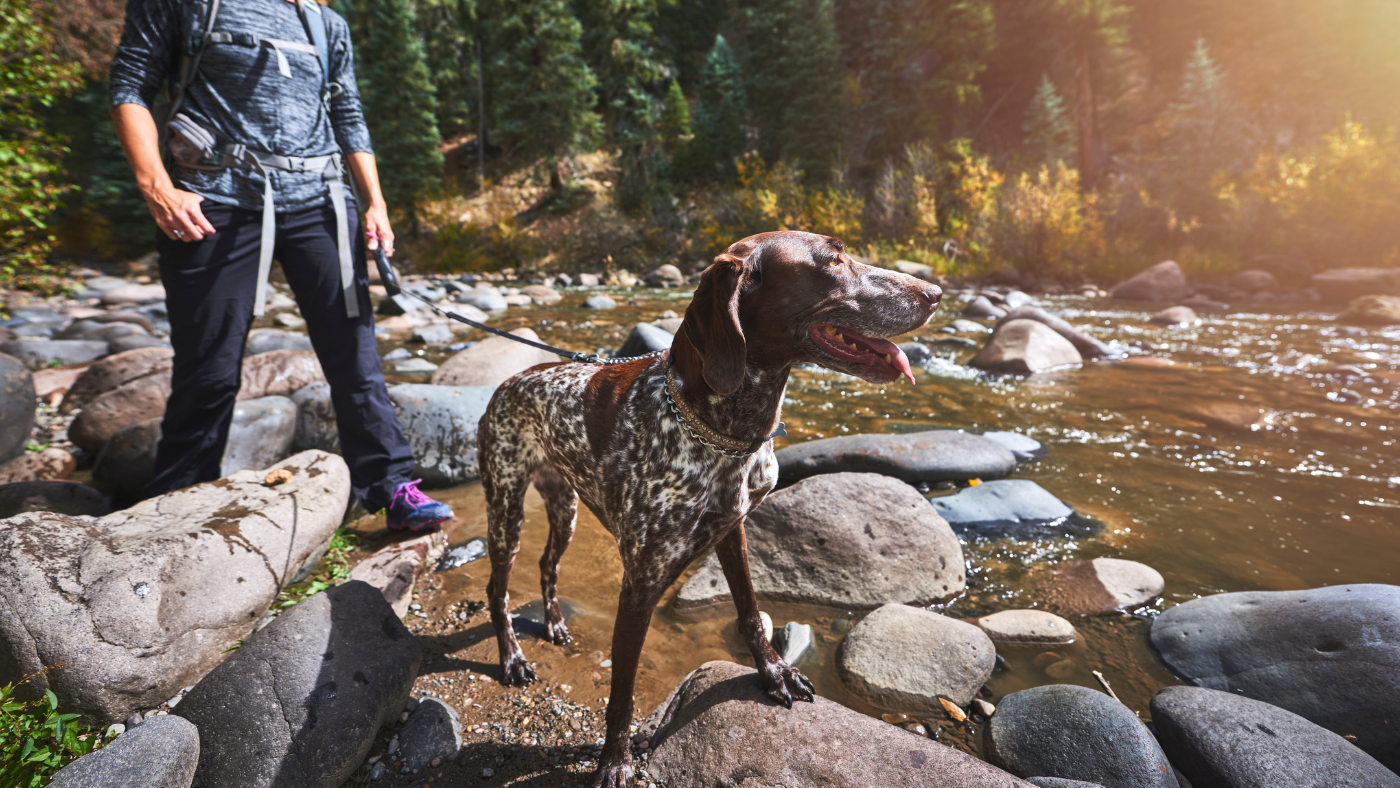As summertime approaches and temperatures rise, humans and dogs alike look forward to spending more time outdoors. Hiking is a great way to get some exercise while exploring nature, and taking your dog along can turn your hike into an enjoyable bonding experience for you both.
To keep your hiking adventure safe and fun, careful planning is essential. Here’s what to know before you hit the trail with your dog.
Make sure your dog is trail-ready
Not all dogs make suitable hiking companions. You don’t want to push your dog to do too much, so carefully consider your dog’s fitness level, age, breed, and size. Even though puppies seem to have boundless energy, young dogs are vulnerable to growth plate injuries until their bones are fully mature, and are not ready for lengthy or challenging hikes. On the other hand, old dogs lose strength and stamina as they age, and often develop joint problems. Overweight dogs may not be able to handle strenuous activity, small dogs might need to stick to shorter distances, and brachycephalic breeds — such as pugs, boxers, and bulldogs — are particularly at risk for overheating and breathing problems.
Your best bet is to talk to your vet. Ask whether your dog is healthy enough to hike and what distances and trail conditions your dog can handle. Once you have the go-ahead from your veterinarian, keep in mind that your dog may still need to build stamina and endurance with shorter, regular walks before taking on a substantial hike, especially if your dog hasn’t been as active over the winter.
You’ll also want to make sure your dog is up to date on their vaccinations and medications, particularly those for parasites, fleas, and ticks, which they’re more likely to encounter in the wild. It’s a good idea to brush up on basic obedience training, too. It’s easier to keep your pup safe if they can reliably “sit,” “stay,” “leave it,” and “come” on command.
Choose your trail wisely
First, it’s important to find a trail where dogs are allowed, and research leash laws and any other relevant rules. Many national parks and state parks do not allow dogs; check websites or call ahead of time for the most up-to-date information. Other considerations when choosing a hiking trail are: the amount of shade, the length of the trail, the elevation gain, and trail surface conditions. Keep in mind that steep climbs, as well as rocky, muddy, or icy paths, could be too challenging for even fit and healthy dogs. Many hiking apps, such as AllTrails, allow you to search for dog-friendly trails and parks, and can also give you a good overview of trail conditions and level of difficulty.
Prepare your pack
You’ll need to pack enough provisions for both you and your dog. You might decide to get your dog their own dog hiking pack; if so, keep your pup’s pack light (healthy dogs usually can carry up to 25 percent of their body weight) and carry the heavier items in your own backpack. Make sure you have the following hiking supplies for your dog:
- A comfortable harness and/or collar with ID tags
- A leash (many trails require a 6 ft. leash)
- Enough water for your dog and for you
- Treats and a little dog food, as well as collapsible bowls
- Poop bags
- Dog booties to protect paws if you’ll be hiking on rough or icy terrain
- Pet-safe insect repellant (or a flea and tick collar)
- A first aid kit with tweezers (to remove splinters, ticks, or foreign objects), hydrogen peroxide (to disinfect cuts), gauze pads and bandages (to cover wounds), a wool sock (in case your dog cuts a pad or tears a claw), and any veterinarian-recommended medications (such as an antihistamine to treat seasonal or environmental allergies, or an allergic reaction to a snake or insect bite)
Beware of hiking hazards
Before you venture out, it’s always a good idea to research any dangers you might encounter on your hike, and learn how to avoid them. Here are a few common hazards to consider.
- Heat: Dogs are more sensitive to heat than humans, and are more prone to overheating or becoming dehydrated. In addition to providing lots of water, it’s important to seek out shade and take regular breaks. Watch for warning signs of overheating or overexertion — excessive panting or drooling, foaming at the mouth, stumbling, and lying down are signs that your dog needs to rest right away.
- Standing water: Don’t let your dog drink from puddles, ponds, or lakes. Standing water can harbor parasites, which can cause gastrointestinal diseases, or dangerous bacteria such as leptospirosis, which can make your dog very sick.
- Poisonous plants: Make sure you can identify and avoid dangerous plants that you might encounter, such as poison ivy, poison oak, poison sumac, stinging nettles, milkweed, poison hemlock, foxglove, rhodendrons, and others local to your area.
- Foxtails: Foxtail plants are grass-like weeds commonly found along trails in the Western half of the U.S. While they appear harmless, the barbed seeds on the head of the plant can become imbedded in your dog’s skin and then burrow into their body, causing serious problems.
- Wildlife: Learn about what wild animals might live in the area you’re hiking, and know what to do should you encounter them. Always be aware of your surroundings, keep a close eye on your dog, and avoid hiking at dawn, dusk, and nighttime, when wildlife is most active. You might want to carry bear spray if you’ll be hiking in bear country, and if your hiking trails are frequented by rattlesnakes, consider enrolling your dog in rattlesnake training, in which dogs are trained to smell and hear rattlesnakes and then retreat if they detect one.
Use good hiking etiquette
When you’re hiking with your dog, stay on designated trails so as to minimize your impact on the environment, and pay attention to leash laws. Even if a trail allows your dog to go off-leash, it’s best to keep your dog leashed at all times when hiking — not only will having your dog on a leash help keep them safe from common hiking hazards, but it will also keep your dog from disturbing others on the trail. Bear in mind that other hikers may not be comfortable interacting with your dog, even if your dog is friendly. When you do encounter others along the trail, be sure to keep your dog close to you, and step to the side to let others pass.
Also, remember that the Leave No Trace principle that humans are familiar with applies to pets, too! Don’t leave dog waste on the trail — it’s bad for the local ecosystem and is inconsiderate of other hikers. Clean up your dog’s poop, and carry it with you to dispose in a trash can after your hike. On long, multi-day backpacking trips, you’ll need to bury pet waste in a hole at least 6 to 8 inches deep and at least 200 feet from trails, camps, and water sources.
Pamper your dog post-hike
After your hike, carefully inspect your dog’s skin for any ticks or foxtails. Brush out their coat, remove any burrs or other objects clinging to their fur, and check their paw pads for injuries. If your dog was splashing around in standing water like a pond or lake, you'll want to give them a bath to remove any pollutants or toxins from their fur and skin. And finally, give your tired hiking partner lots of snuggles and cuddles — and their favorite Tartar Shield treat — as a reward for a job well done!



